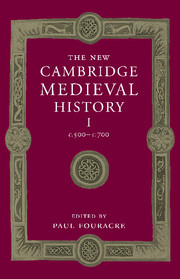Book contents
- Frontmatter
- Introduction: the history of Europe 500–700
- 1 The later Roman Empire
- 2 The Barbarian invasions
- 3 The sources and their interpretation
- PART I THE SIXTH CENTURY
- PART II THE SEVENTH CENTURY
- 11 The Byzantine empire in the seventh century
- 12 Muhammad and the rise of Islam
- 13 The Catholic Visigothic kingdom
- 14 Francia in the seventh century
- 15 Religion and society in Ireland
- 16 Christianity amongst the Britons, Dalriadan Irish and Picts
- 17 England in the seventh century
- 18 Scandinavia
- 19 The Slavs
- PART III THEMES AND PROBLEMS
- List of Primary sources
- Bibliography of secondary works arranged by chapter
- Index
- Frontispiece"
- Plate section"
- Map 3 Gaul/Francia in the sixth and seventh centuries"
- References
18 - Scandinavia
from PART II - THE SEVENTH CENTURY
Published online by Cambridge University Press: 28 March 2008
- Frontmatter
- Introduction: the history of Europe 500–700
- 1 The later Roman Empire
- 2 The Barbarian invasions
- 3 The sources and their interpretation
- PART I THE SIXTH CENTURY
- PART II THE SEVENTH CENTURY
- 11 The Byzantine empire in the seventh century
- 12 Muhammad and the rise of Islam
- 13 The Catholic Visigothic kingdom
- 14 Francia in the seventh century
- 15 Religion and society in Ireland
- 16 Christianity amongst the Britons, Dalriadan Irish and Picts
- 17 England in the seventh century
- 18 Scandinavia
- 19 The Slavs
- PART III THEMES AND PROBLEMS
- List of Primary sources
- Bibliography of secondary works arranged by chapter
- Index
- Frontispiece"
- Plate section"
- Map 3 Gaul/Francia in the sixth and seventh centuries"
- References
Summary
Our image of the societies of Scandinavia (present-day Denmark, Sweden and Norway) in the late Iron Age has been based predominantly on their economic character, involving aspects such as agriculture and settlement, economy and society, trade and urbanisation. Combined with studies of burial evidence, these topics have been the starting point for models of the social and political situation, including the earliest form of state-formation in Scandinavia. In more recent years, however, ideological aspects of late pre-Christian society have also started to come into focus. A number of new excavations have contributed to a keener interest in ‘cult sites’, while major new finds of gold hoards have encouraged interpretations using terms such as ‘ideology’, ‘kings’, ‘aristocracy’ and the like. This has provided a concrete counterpart to Old Norse literature, new directions in research into the history of religion, and in place-name studies. A new, interdisciplinary research movement is developing around these issues where religious, judicial and political conditions are seen as closely interwoven and where an alternative understanding of the connection between political authority, myths and memory, cult activity, skilled craft production and exercise of power has emerged. In the following outline, I have decided to concentrate mainly on this new approach. First, however, special attention will be paid to Scandinavia as part of early medieval Europe.
Keywords
- Type
- Chapter
- Information
- The New Cambridge Medieval History , pp. 496 - 523Publisher: Cambridge University PressPrint publication year: 2005
References
- 2
- Cited by



